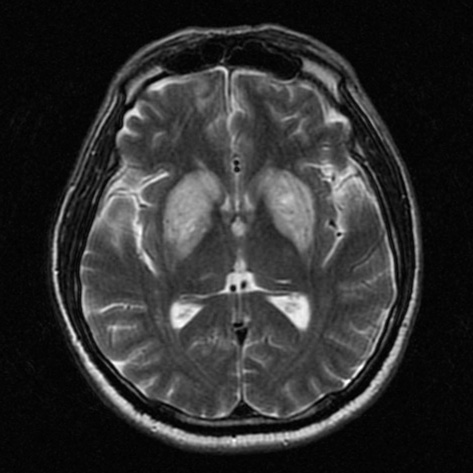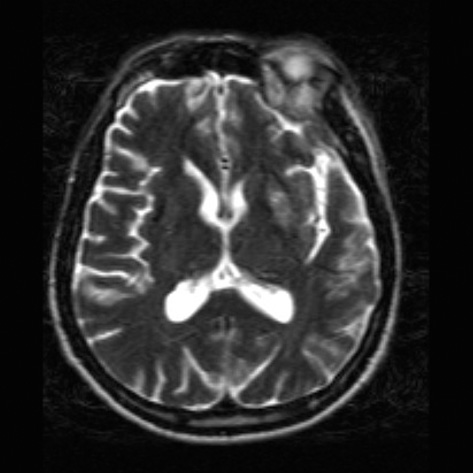J Korean Med Sci.
2008 Jun;23(3):533-536. 10.3346/jkms.2008.23.3.533.
A Case of a Patient with Both Chorea and Restless Legs Syndrome
- Affiliations
-
- 1Department of Psychiatry, St. Vincent's Hospital, The Catholic University of Korea College of Medicine, Suwon, Korea. hscjohn@hotmail.com
- 2Department of Radiology, St. Vincent's Hospital, The Catholic University of Korea College of Medicine, Suwon, Korea.
- KMID: 1786897
- DOI: http://doi.org/10.3346/jkms.2008.23.3.533
Abstract
- The patient was a 44-yr-old man with end-stage renal disease who had developed chorea as a result of hypoglycemic injury to the basal ganglia and thalamus and who was subsequently diagnosed with depression and restless legs syndrome (RLS). For proper management, the presence of a complex medical condition including two contrasting diseases, chorea and RLS, had to be considered. Tramadol improved the pain and dysesthetic restlessness in his feet and legs, and this was gradually followed by improvements in his depressed mood, insomnia, lethargy, and feelings of hopelessness. This case suggests that the dopaminergic system participates intricately with the opioid, serotoninergic, and noradrenergic systems in the pathophysiology of RLS and pain and indirectly of depression and insomnia.
Keyword
MeSH Terms
-
Adult
Analgesics, Opioid/therapeutic use
Anti-Dyskinesia Agents/therapeutic use
Chorea/*complications/pathology
Citalopram/therapeutic use
Drug Therapy, Combination
Haloperidol/therapeutic use
Humans
Kidney Failure, Chronic/*complications
Magnetic Resonance Imaging
Male
Restless Legs Syndrome/*complications/drug therapy/pathology
Serotonin Uptake Inhibitors/therapeutic use
Tramadol/therapeutic use
Figure
Reference
-
1. Cardoso F, Seppi K, Mair KJ, Wenning GK, Poewe W. Seminar on choreas. Lancet Neurol. 2006. 5:589–602.
Article2. American Academy of Sleep Medicine. International classification of sleep disorders. Diagnostic and coding manual. 2005. 2nd ed. Westcher, IL: American Academy of Sleep Medicine;81–86.3. Polydefkis M, Allen RP, Hauer P, Earley CJ, Griffin JW, McArthur JC. Subclinical sensory neuropathy in late-onset restless legs syndrome. Neurology. 2000. 55:1115–1121.
Article4. Allen RP, Earley CJ. Restless legs syndrome. A review of clinical and pathophysiologic features. J Clin Neurophysiol. 2001. 18:128–147.5. Turjanski N, Lees AJ, Brooks DJ. Striatal dopaminergic function in restless legs syndrome: 18F-dopa and 11C-raclopride PET studies. Neurology. 1999. 52:932–937.
Article6. Michaud M, Soucy JP, Chabli A, Lavigne G, Montplaisir J. SPECT imaging of striatal pre- and postsynaptic dopaminergic status in restless legs syndrome with periodic leg movements in sleep. J Neurol. 2002. 249:164–170.
Article7. Allen RP, Earley CJ. Restless legs syndrome: a review of clinical and pathophysiologic features. J Clin Neurophysiol. 2001. 18:128–147.8. Mizuno S, Mihara T, Miyaoka T, Inagaki T, Horiguchi J. CSF iron, ferritin and transferrin levels in restless legs syndrome. J Sleep Res. 2005. 14:43–47.
Article9. Brodeur C, Montplaisir J, Godbout R, Marinier R. Treatment of restless legs syndrome and periodic movements during sleep with Ldopa: a double-blind, controlled study. Neurology. 1988. 38:1845–1848.
Article10. DeLong MR. Primate models of movement disorders of basal ganglia origin. Trends Neurosci. 1990. 13:281–285.
Article11. Loescher W, Hoenack D, Taylor CP. Gabapentin increases aminooxyacetic acid-induced GABA accumulation in several regions of rat brain. Neurosci Lett. 1991. 128:150–154.12. Agid Y, Bonnet AM, Ruberg M, Javoy-Agid F. Pathophysiology of L-dopa-induced abnormal involuntary movements. Psychopharmacology. 1985. 2:(Suppl). 145–159.
Article13. Rao ML. Gabapentin augments whole blood serotonin in healthy young men. J Neural Transm. 1988. 73:129–134.
Article14. Walters AS. Review of receptor agonist and antagonist studies relevant to the opiate system in restless legs syndrome. Sleep Med. 2002. 3:301–304.
Article15. Lauerma H, Markkula J. Treatment of restless legs syndrome with tramadol: an open study. J Clin Psychiatry. 1999. 60:241–244.



